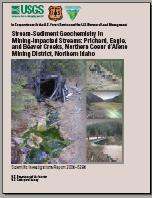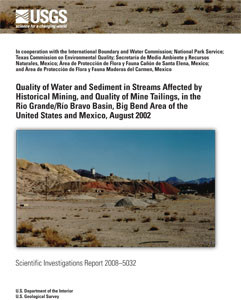
Product Details
- Product Number
- 205330
- Series
- SIR-2004-5284
- Scale
- NO SCALE
- Alternate ID
- SIR2004-5284
- ISBN
- 978-0-607-97177-4
- Authors
- JOHN C WALLIS
- Version Date
- 01/01/2004
- Regions
- ID
- Countries
- USA
- Media
- Paper
- Format
- Bound
Additional Details
- Description
- This report presents the results of one aspect of an integrated watershed-characterization study that was undertaken to assess the impacts of historical mining and milling of silver-lead-zinc ores on water and sediment composition and on aquatic biota in streams draining the northern part of the Coeur d'Alene Mining District in northern Idaho. We present the results of chemical analyses of 62 samples of streambed sediment, 19 samples of suspended sediment, 23 samples of streambank soil, and 29 samples of mine- and mill-related artificial- fill material collected from the drainages of Prichard, Eagle, and Beaver Creeks, all tributaries to the North Fork of the Coeur d'Alene River. All samples were sieved into three grain-size fractions (<0.063, 0.063-0.25, and 0.25-1.0 mm) and analyzed for 40 elements after four-acid digestion by inductively coupled plasma atomic-emission spectrometry and for mercury by continuous-flow cold-vapor atomic-absorption spectrometry in the U.S. Geological Survey laboratory in Denver, Colo. Historical mining of silver-lead-zinc ores in the headwater reaches of the Prichard Creek, Eagle Creek, and Beaver Creek drainages has resulted in enrichments of lead, zinc, mercury, arsenic, cadmium, silver, copper, cobalt, and, to a lesser extent, iron and manganese in streambed sediment. Using samples collected from the relatively unimpacted West Fork of Eagle Creek as representative of background compositions, streambed sediment in the vicinity of the mines and millsites has Pb and Zn contents of 20 to 100 times background values, decreasing to 2 to 5 times background values at the mouth of the each stream, 15 to 20 km downstream. Lesser enrichments (<10 times background values) of mercury and arsenic also are generally associated with, and decrease downstream from, historical silver-lead-zinc mining in the drainages. However, enrichments of arsenic and, to a lesser extent, mercury also are areally associated with the lode gold deposits along Prichard Creek near Murray, which were not studied here. Metal contents in samples of unfractionated suspended sediment collected during a high-flow event in April 2000 are generally similar to, but slightly higher than, those in the fine ( <0.063-mm grain size) fraction of streambed sediment from the same sampling site. Although metal enrichment in streambed sediment typically begins adjacent to the mine portals and their associated mine-waste rock dumps, volumetrically larger inputs of metal-enriched materials were contributed by the ore-concentration millsites and their associated, more finely ground, more metal rich mill-tailings impoundments
- Survey Date
- 2005
- Print Date
- 2005
- Two Sided
- Yes
- Pieces
- 1
- Languages
- English
Related Items





